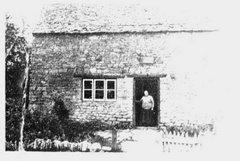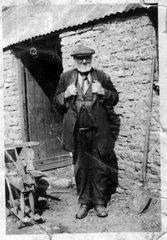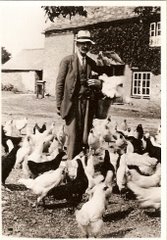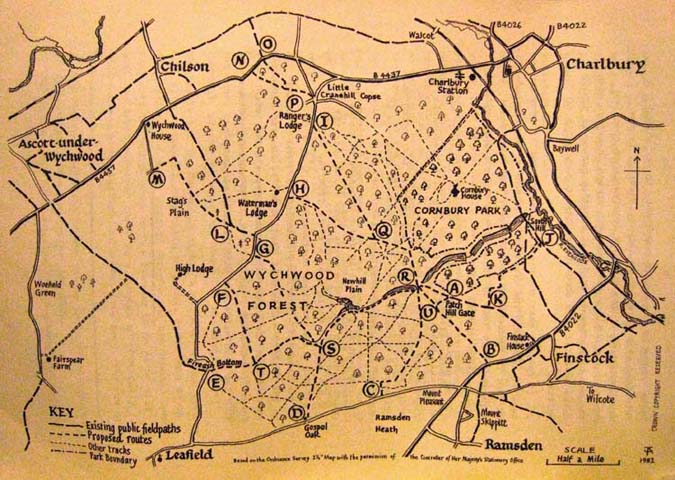
FYNSTOKE TO FINSTOCK: A Short History
Finstock, together with its neighbours Charlbury, Fawler and Leafield, used to lie in a clearing in Wychwood Forest that stretched from Woodstock to Burford.
In 1135 the village of Finstock is referred to as Fynstoke. At this time the village formed part of the manor and parish of Charlbury. Roman coins and Romano-British potsherds have been found in the village and it is thought that there was certainly a settlement of some kind here at the time of the Domesday survey of 1086 when it formed part of the 'Hundred of Banbury' belonging to the Bishop of Lincoln.
Later much of the forest was cleared for growing arable crops, and, during the Middle Ages, barley was the main crop in Finstock. Other land was used for sheep grazing, and many of the Finsock people were involved in the woollen industry — the carding being done by men and boys and the spinning by women.
In the early 1500s the manor of Charlbury and its land, including Finstock, was owned by Sir Thomas White, a London tailor who founded St John's College in Oxford in 1555. The manor was included in the college's endowment. As the college lands were owned by an absentee landlord, the land was leased to many people including the Lee family of Ditchley Park (from 1592-1776). The college then resumed direct control until 1857 when the lordship of the manor passed to Francis Spencer, 2nd Lord Churchill of Wychwood, the owner of Cornbury Park. It still remains in the possession of Cornbury Park today although most of the manorial rights have lapsed and much of the village of Finstock is now freehold.
During the early part of the twentieth century the principal occupations in Finstock were glove-making at the village hall site, carried out by women, while the men and boys worked as agricultural labourers on the land. Today most inhabitants of the village commute by car and bus to Witney, Chipping Norton and Oxford.
Finstock is now a separate civil and ecclesiastical parish, its population mostly living on the sides of th large triangle formed by the main Witney-Charlbury road, School road and the High Street. In recent decades there has benn much in-filling with new buildings to complete the triangle. Four new estates were built during the last century. The farming now is mainly arable: barley, wheat and oilseed rape being the main crops, although some mixed farming is still found.
T.S Eliot came to Finstock to be received into the Church of England. William Force Stead, who was a fellow American, came to England as an American consul, but was later ordained and became chaplain of Worcester College, Oxford. After Stead met Eliot in 1923 (they shared a love of cats!), Eliot became drawn to Anglicanism and Stead agreed to baptise him. Stead was then living in Finstock Manor, which he described as a "fine seventeenth-century gabled house". He invited Eliot to stay at the Manor before his baptism, which took place in Finstock Church on June 29th, 1927.
In 1135 the village of Finstock is referred to as Fynstoke. At this time the village formed part of the manor and parish of Charlbury. Roman coins and Romano-British potsherds have been found in the village and it is thought that there was certainly a settlement of some kind here at the time of the Domesday survey of 1086 when it formed part of the 'Hundred of Banbury' belonging to the Bishop of Lincoln.
Later much of the forest was cleared for growing arable crops, and, during the Middle Ages, barley was the main crop in Finstock. Other land was used for sheep grazing, and many of the Finsock people were involved in the woollen industry — the carding being done by men and boys and the spinning by women.
In the early 1500s the manor of Charlbury and its land, including Finstock, was owned by Sir Thomas White, a London tailor who founded St John's College in Oxford in 1555. The manor was included in the college's endowment. As the college lands were owned by an absentee landlord, the land was leased to many people including the Lee family of Ditchley Park (from 1592-1776). The college then resumed direct control until 1857 when the lordship of the manor passed to Francis Spencer, 2nd Lord Churchill of Wychwood, the owner of Cornbury Park. It still remains in the possession of Cornbury Park today although most of the manorial rights have lapsed and much of the village of Finstock is now freehold.
During the early part of the twentieth century the principal occupations in Finstock were glove-making at the village hall site, carried out by women, while the men and boys worked as agricultural labourers on the land. Today most inhabitants of the village commute by car and bus to Witney, Chipping Norton and Oxford.
Finstock is now a separate civil and ecclesiastical parish, its population mostly living on the sides of th large triangle formed by the main Witney-Charlbury road, School road and the High Street. In recent decades there has benn much in-filling with new buildings to complete the triangle. Four new estates were built during the last century. The farming now is mainly arable: barley, wheat and oilseed rape being the main crops, although some mixed farming is still found.
T.S Eliot came to Finstock to be received into the Church of England. William Force Stead, who was a fellow American, came to England as an American consul, but was later ordained and became chaplain of Worcester College, Oxford. After Stead met Eliot in 1923 (they shared a love of cats!), Eliot became drawn to Anglicanism and Stead agreed to baptise him. Stead was then living in Finstock Manor, which he described as a "fine seventeenth-century gabled house". He invited Eliot to stay at the Manor before his baptism, which took place in Finstock Church on June 29th, 1927.
Subscribe to:
Posts (Atom)







